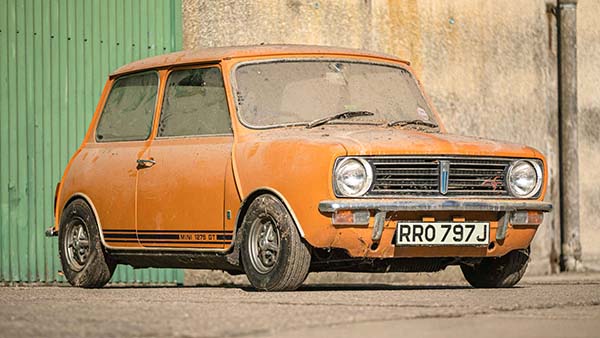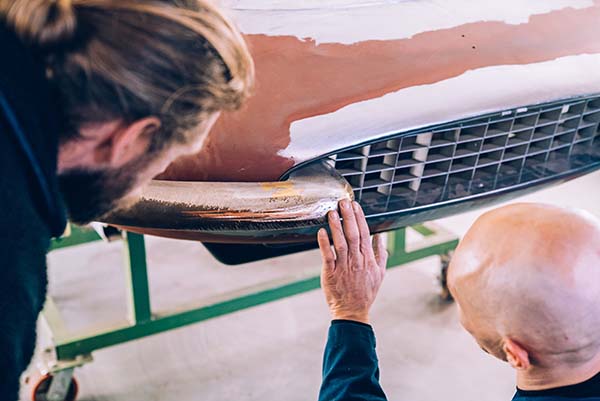FJ GUIDE: WHEN SHOULD YOU WALK FROM A RESTORATION PROJECT?
At this year’s Practical Classics Classic Car & Restoration Show, the Footman James team witnessed a historic moment. A 1970 Mini 1275 GT requiring a full restoration sold at auction for four times its estimate, the final bid amounting to an eye-watering £39,100.
With the hammer price exceeding the usual book value of a restored example, this got us thinking about the increasing value of many classics… and how this may encourage owners to take on increasingly ambitious projects as the maths begins to make sense. Is there ever a time you should walk away from a restoration project, regardless of its potential?

Credit - Classic Car Auctions
Bodywork expert Frank Phillips runs Austin Morris Services on the Isle of Wight and has restored everything from Minis to Aston Martins. During his career, he’s encountered his fair share of horror stories and has some canny advice for enthusiasts considering taking the plunge.
“Beware of restoration businesses taking money upfront before starting your project,” begins Frank. “I’ve seen so many customers who have been conned, who gave their project car and an upfront fee to a business – who then didn’t work on it. There are still businesses out there who will try to fool their customers, such as bodging cars with filler.”
If you’re commissioning someone else to work on your project, Frank suggests arranging regular photos and visits to help you keep track of progress, along with regular payments as the work takes place.
“You must be wise to how you’re spending a substantial amount of money on a restoration – if you don’t see the car as an investment, this is another reason for deciding to walk away.
“It’s also important to have a connection to the car because that is what will see the project through. A customer inherited a Ford Capri 3.0 which required £10k-20k worth of restoration work, but the restoration made sense because the car was worth around £30,000 finished.”
Poor parts availability can be a major sticking point on projects, with the cost of manufacturing bespoke items often being preventative. However, technological advances in 3D printing now means many previously unobtainable items are now back in decent supply in the aftermarket.
“Know what you’re getting into with the type of classic you want to restore before you start,” Frank continues. “Front wings for Morris Marinas used to cost £30 not so long ago, but today they could be worth £300 because they’re now so rare.”
“When choosing a restoration project to buy, consider bringing an expert along with you. They will be able to advise you on its condition, by checking panel gaps, signs of chassis repairs and even if it’s a cut-and-shut. A bodywork expert should immediately spot when something is deliberately hidden.”

Credit - Bell Sport & Classic
When viewing a project, Footman James suggests undertaking the following practical checks:
- Check everywhere you can for rot – especially in hard-to-reach structural areas
- Does the car have matching numbers? If the engine and chassis don’t match, make sure you understand the reason why
- Look out for excessive or freshly applied underseal, which may be hiding unseen horrors
- Don’t let your heart rule your head – research vehicle values and understand the restoration costs as a worst-case scenario, to minimise the risk of an unfinished project
- Ask as many questions as you can about the car and its history – the current owner is likely to be a fantastic source of knowledge about the car and its life so far, so get the info while you can. They may even be able to offer you photos that tell the car’s story further
- If the car is a genuine special edition, make sure it’s the real deal – bear in mind that some genuine rare model specifications may not show up on the vehicle logbook (V5C). Popular British classics may have a Heritage Certificate which confirms the engine and chassis numbers, as well as other essential credentials to help you make an informed decision
As classics like that aforementioned Mini 1275 GT continue to enjoy a renaissance in demand and appreciation, it can be easier than ever to financially justify restoring a car without spending above and beyond its final value.
Many will have seen how strong the values of classic Fords have become - even British Leyland’s Triumph Stag and Dolomite Sprint are beginning to follow the same sharp trajectory.
It's easy to get carried away with a project – and far be it from us to judge anyone progressing a project led by the heart. The satisfaction that comes from saving a classic car from beyond the brink is something you can’t possibly put a price on… But by following the advice of experienced professionals like Frank, you’re much less likely to end up losing your shirt.
Have you ever walked away from a restoration nightmare? Share any other tips you may have in the comments below.

COMMENT